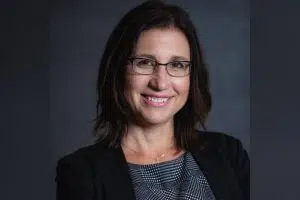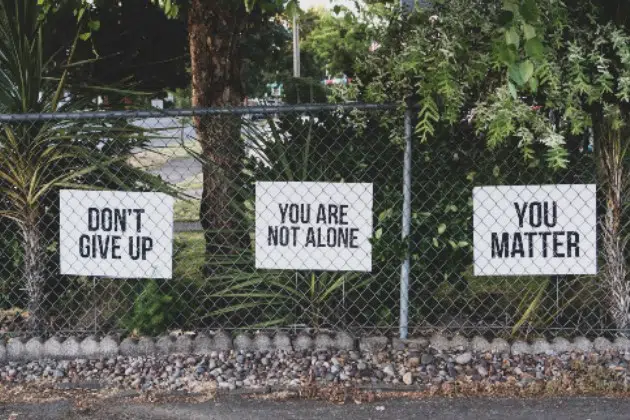(KNSI) – September is National Suicide Prevention Month, and two St. Cloud area mental health professionals are weighing in on how to seek help if you or someone you know needs it.
“In the United States, there’s about 14 suicides per 100,000 people,” said Roy Neumann. That figure refers to annual data from 2019. “In Minnesota, we’re right about at that number.”
Neumann is a mental health crisis co-responder with the Central Minnesota Mental Health Center. Four days a week, he’s out in the field with Sherburne County law enforcement officers responding to mental health crisis calls. Neumann will connect people to mental health treatment, or in some instances, help de-escalate a crisis situation.
When it comes to which demographics are the most affected by suicide, Neumann says that, despite suicide being the second-highest cause of death for people ages 10 to 34, a lot of people assume that teens are the most at risk.
“The group of people that is most affected by suicide right now is middle-aged, white men,” Neumann said. “That’s not generally something people think about when they think about suicide. Over the last 10 years, the research has indicated older men, sometimes even senior citizen men, but now that age group has kind of dropped back down into that 45-and-above range.”
People who die by suicide are disproportionately male, says Paige McConkey, a trauma informed advocate and coordinator for the St. Cloud Area Child Response Initiative.
“Helping people to engage in those conversations, normalize those conversations, kind of bring it out of the dark so people can really seek help, they can find that there is hope available, and ultimately that healing and recovery can happen.”
“The lesbian, gay and bisexual youth community [is] four times more likely to attempt suicide than straight youth,” McConkey adds. “Also, transgender adults are more likely to attempt suicide than the general population.”
In his work, McConkey also works with area law enforcement (specifically St. Cloud, Waite Park and Sartell). Police departments refer cases to McConkey where children have experienced trauma or a mental health crisis, and he helps connect them with trauma-informed mental health care services.
“One of the things, I think, regarding suicide is the importance of destigmatizing and normalizing conversations around suicide,” McConkey said. “Oftentimes we find that when those thoughts are held in secret, unfortunately, people don’t get the help that they need. … Part of being a part of a mental health organization is helping people to engage in those conversations, normalize those conversations, kind of bring it out of the dark so people can really seek help, they can find that there is hope available, and ultimately that healing and recovery can happen.”
What to look for & how to help
Neumann says if you think someone in your life is sharing suicidal thoughts or could be considering suicide, there are multiple resources out there to help them. If they are in an emergency or critical situation, calling 911 or a mental health crisis hotline is a resource you can use.
“I had a woman that I was working with last week who apologized for calling us — I said, ‘You don’t need to apologize,'” Neumann said. “‘This is the time to intervene, when this person is in crisis.’ You don’t know what we can or can’t do to help the situation, so please call.”
Neumann recommends saving a mental health crisis line in your cell phone contacts in case you or someone you know needs that resource.
Mental health crisis resources:
- CMMHC’s 24/7 crisis line for Sherburne, Benton, Stearns and Wright counties: 1-800-635-8008
- National crisis text line: Text MN to 741741
- National talk line: 1-800-273-8255
- Local crisis line for Todd, Wadena, Morrison, Cass, Crow Wing and Aitkin counties: 1-800-462-5525
- Local crisis line for Mille Lacs, Kanabec and Isanti counties: 1-800-523-3333
If someone is not in an emergency situation, Neumann says one of the best things to do is to listen.
“Nothing replaces good, active listening,” he said. “Those of us who’ve worked in the business 20 years or more, our best skill we bring to the table is our two ears and our ability to keep a person talking. So, make sure that that person that you’re talking to keeps talking, and be genuine. Just listen.”
Neumann adds that youth should also seek help from a trusted adult, like a parent or teacher.
“I think that, oftentimes, people who are experiencing suicidal ideation and thoughts feel very alone, feel very isolated. We want them to be able to understand that they are not alone, that there is help.”
Some things to look out for that could be risk factors for suicidal thoughts or actions, according to Neumann: a sudden increase in alcohol or drug use, past suicide attempts, access to firearms or other lethal means, knowing someone else who died by suicide, impulsivity and social isolation.
“Watch for people who move away from friends; maybe this is a person who’s been very active, and now for the past month they’ve been avoiding going out,” Neumann said. “Watch for people who have recent losses, some significant job loss, significant financial loss, maybe some legal issues or criminal issues.
“I think that, oftentimes, people who are experiencing suicidal ideation and thoughts feel very alone, feel very isolated,” McConkey added. “We want them to be able to understand that they are not alone, that there is help.”
Continuing issues
However, there are still some big barriers for mental health care in general.
In his work, McConkey says he’s noticed that the COVID-19 pandemic has possibly exposed the lack of capacity, at a societal level, for us to deal with trauma.
“I think we’ve seen a significant increase in people who might consider themselves unaffected by adversity or trauma … who are really struggling,” he said. “I think more and more people are realizing that they need someone that they can talk to that they can be able to process with and understand how to be able to cope with the stress that they’re going through.”
But when it comes to therapy or other mental health support services, Neumann says those resources are inaccessible to some people.
“Coming from my street level view of what’s happening in the world, especially here in Central Minnesota, there seems to be a disconnect from the people who need the help and the people who actually seek the help,” Neumann said. “There are people who don’t have access to a therapist close to their home. Right now, there is a tremendous shortage in the areas that I serve.”
What’s needed: Getting more providers into more Minnesota communities.
“So, having providers who work in rural clinics,” Neumann said. “Having providers working at multiple clinics or having the availability to do sessions over telehealth or do sessions in the home. Getting the service to the people who need it is sometimes a barrier to suicide prevention.”
The CMMHC has a list of resources for suicide prevention and other concerns and topics surrounding mental health and well-being on its website.










